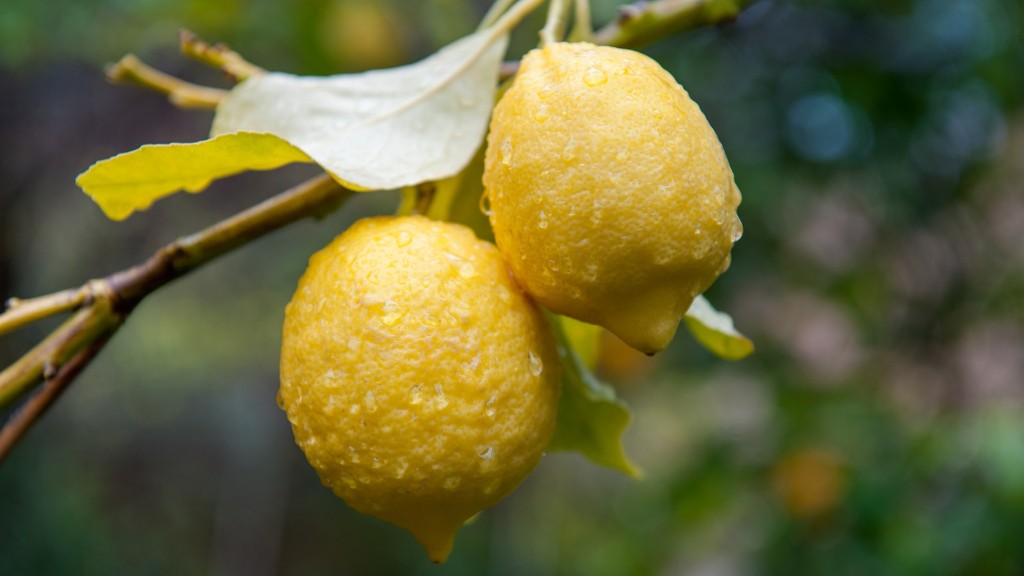If your lemon tree is not thriving, there is hope for it yet. Many homeowners with ailing lemon trees have managed to bring their once-declining trees back to life and can enjoy the delicious fruit from their own trees. With the right care, lemon trees can live for many years and fruit in abundance.
The first step in bringing lemon tree back to life is to determine the cause of the tree’s decline. Most often, lemon tree decline is caused by inadequate water and nutrients. Environmental factors such as temperature extremes, drought, and wind damage can also contribute to a lemon tree’s decline.
The next step is to properly care for the tree by providing adequate water and nutrients. Lemon trees need approximately an inch of water each week, especially during the summer when they are actively growing. If the tree is planted in a pot, be sure to water it more frequently and empty the pot of any rainwater that has collected in the bottom.
It is also important to properly fertilize the lemon tree. Fertilize the tree every few months with a balanced fertilizer such as 8-8-8 or 10-10-10. Be sure to follow the instructions on the fertilizer package for the proper application rate. Additionally, applying compost to the soil around the lemon tree can help to provide extra nutrients.
It is also important to prune the lemon tree to maintain its shape and size. Pruning helps to encourage new growth and also makes it easier for you to harvest the fruit. This should be done in the late winter or early spring before the tree begins to bloom. Be sure to use clean and sharp pruning shears and only remove dead or diseased branches.
Finally, regularly inspect the tree for signs of pests or diseases. Controlling insects and diseases early can help prevent more serious damage. Be sure to remove any infested leaves or branches and treat the tree with insecticidal soap or horticultural oil.
Diseases and Pests
Diseases and pests can be a common issue for lemon trees. Common pests that can cause significant damage include aphids, mealybugs, and scale. If you suspect your tree has a pest problem, it is important to take action quickly. Check the undersides of leaves and twigs, and if you suspect a pest problem, apply a pesticide as soon as possible.
Additionally, you should regularly inspect your tree for signs of disease. Common diseases which can affect lemon trees include canker, leaf spot, fusarium fungus, and bacterial spot. If you detect any of the above diseases, you will need to treat the tree with a fungicide. Be sure to follow the directions on the fungicide label for correct application and safety.
Finally, maintain a moist and healthy soil to help protect the tree from disease and pests. Mulching the soil around the base of the tree can help keep moisture in the soil and maintain a consistent soil temperature. Also, be sure to water your tree regularly and remove any fallen leaves or twigs.
Light and Temperature
Lemon trees need plenty of light in order to produce fruit. Sufficient light helps promote healthy growth and can even help protect the tree from drought and heat stress. Lemon trees thrive best when they receive at least 8 hours of sunlight per day, so be sure to plant your tree in an area that gets plenty of sunlight.
It is also important to note that lemon trees do not tolerate temperatures below freezing. If you live in a cold winter climate, be sure to protect your tree during the winter by either moving the tree indoors or placing a cover over it in cold weather. Additionally, avoid pruning in the late winter or early spring when frost is still present.
Lemon trees also need protection from heat. If the temperature surpasses 90°F for a few days in a row, be sure to provide shade for the tree. This can be done by erecting a temporary shade cloth over the tree or by positioning a larger tree or other structure so that it shades the lemon tree.
It is also important to keep an eye on the relative humidity. Lemon trees thrive best when the relative humidity is between 50-60%. During the summer, misting the leaves of the tree or placing a shallow tray of water near the tree can help increase the humidity around the tree.
Harvest and Pruning
Lemon trees need to be pruned regularly in order to remain healthy and encourage new growth. Pruning should be done in late winter or early spring prior to the tree blooming. Be sure to use clean and sharp pruning shears and only remove dead or diseased branches.
It is also important to properly harvest your lemons as this will help encourage future growth. Fruits should be picked when they are ripe, which is usually when the skin starts to turn yellow. Depending on the variety of lemon, you may need to harvest several times a year. Additionally, be sure not to over harvest, as this can hinder the tree’s ability to fruit in the future.
Finally, it is important to keep an eye on the soil to ensure that it is draining properly. If your tree is in a pot, be sure to empty the pot of any accumulation of rainwater, as this will cause the soil to become waterlogged and lead to root rot.
Fertilizing and Watering
If you want to maintain a healthy lemon tree and encourage growth, feeding your tree with fertilizer is essential. Fertilize the tree every few months with a balanced fertilizer such as 8-8-8 or 10-10-10, and follow the instructions on the package for the correct application rate. Additionally, applying compost to the soil can help to provide extra nutrients.
It is also important to properly water the lemon tree. Lemon trees need about an inch of water each week, and should be watered more frequently during the summer months when the tree is actively growing. Be sure to avoid overwatering, as this can lead to root rot and cause the tree to decline.
Finally, mulching around the tree can help retain moisture in the ground and can even help act as a buffer against temperature extremes. The best type of mulch to use for lemon trees is organic material such as wood chips, straw, or grass clippings.
Environmental Factors
In addition to pests and disease, environmental factors can also affect the health of your lemon tree. If your tree is planted in a pot, it is important to move the pot from time to time so that the tree can receive sunlight from different angles. Additionally, avoid planting the tree near cold drafts or in low lying areas where it may be easily flooded.
It is also important to protect the tree against strong winds, which can damage the branches and leaves. If you live in a windy area, consider planting a windbreak to give the tree some additional protection. Lastly, lemon trees can be sensitive to extreme temperatures, so be sure to provide shade or relocate the tree indoors during the hottest parts of the summer.
With a bit of proper care, your lemon tree will be producing big, juicy lemons in no time. With the right care, lemon trees can live for many years, so have patience and enjoy the delicious fruits of your labor.




